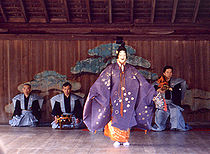
Masterpieces of the Oral and Intangible Heritage of Humanity
Encyclopedia

UNESCO
The United Nations Educational, Scientific and Cultural Organization is a specialized agency of the United Nations...
starting in 2001 to raise awareness on intangible cultural heritage
Intangible cultural heritage
The concept of intangible cultural heritage emerged in the 1990s, as a counterpart to the World Heritage that focuses mainly on tangible aspects of culture...
and encourage local communities to protect them and the local people who sustain these forms of cultural expressions. Several manifestations of intangible heritage around the world were awarded the title of Masterpieces to recognize the value of the non-material component of culture, as well as entail the commitment of states to promote and safeguard the Masterpieces. Further proclamations occurred biennially until 2005.
Until 2005, a total of 90 Masterpieces from 70 countries had been proclaimed. 76 more elements were added on 30 September 2009, during the fourth session of the Committee.
Background
UNESCO defines oral and intangible heritage as “the totality of tradition-based creations of a cultural community expressed by a group or individuals and recognized as reflecting the expectations of a community in so far as they reflect its cultural and social identity.” LanguageLanguage
Language may refer either to the specifically human capacity for acquiring and using complex systems of communication, or to a specific instance of such a system of complex communication...
, literature
Literature
Literature is the art of written works, and is not bound to published sources...
, music
Music
Music is an art form whose medium is sound and silence. Its common elements are pitch , rhythm , dynamics, and the sonic qualities of timbre and texture...
and dance
Dance
Dance is an art form that generally refers to movement of the body, usually rhythmic and to music, used as a form of expression, social interaction or presented in a spiritual or performance setting....
, game
Game
A game is structured playing, usually undertaken for enjoyment and sometimes used as an educational tool. Games are distinct from work, which is usually carried out for remuneration, and from art, which is more often an expression of aesthetic or ideological elements...
s and sports, culinary traditions
Cuisine
Cuisine is a characteristic style of cooking practices and traditions, often associated with a specific culture. Cuisines are often named after the geographic areas or regions that they originate from...
, rituals and mythologies
Mythologies
Mythologies is a book by Roland Barthes, published in 1957. It is a collection of essays taken from Les Lettres nouvelles, examining the tendency of contemporary social value systems to create modern myths...
, knowledge and practices concerning the universe, know-how linked to handicrafts, and cultural spaces are among the many forms of intangible heritage. Intangible heritage is seen as a repository of cultural diversity
Cultural diversity
Cultural diversity is having different cultures respect each other's differences. It could also mean the variety of human societies or cultures in a specific region, or in the world as a whole...
, and creative expression, as well as a driving force for living cultures. Since it can be vulnerable to forces of globalization
Globalization
Globalization refers to the increasingly global relationships of culture, people and economic activity. Most often, it refers to economics: the global distribution of the production of goods and services, through reduction of barriers to international trade such as tariffs, export fees, and import...
, social transformation
Social transformation
One definition of Social transformation is the process by which an individual alters the socially ascribed social status of their parents into a socially achieved status for themselves. However another definition refers to large scale social change as in cultural reforms or transformations...
, and intolerance
Toleration
Toleration is "the practice of deliberately allowing or permitting a thing of which one disapproves. One can meaningfully speak of tolerating, ie of allowing or permitting, only if one is in a position to disallow”. It has also been defined as "to bear or endure" or "to nourish, sustain or preserve"...
, UNESCO encourages communities to identify, document, protect, promote and revitalize such heritage.

Although UNESCO has had a program (active since 1972) to protect the world’s cultural and natural heritage, known as the World Heritage List, it thought that the List was directed mostly to the protection and representation of tangible, monumental elements of past cultures or natural environment. The Masterpieces of the Oral and Intangible Heritage of Humanity, is UNESCO’s response to the call for humanity to widen its concept of cultural heritage by bringing in the intangible aspects.
The idea for the project came from people concerned about Morocco
Morocco
Morocco , officially the Kingdom of Morocco , is a country located in North Africa. It has a population of more than 32 million and an area of 710,850 km², and also primarily administers the disputed region of the Western Sahara...
’s Jeema’ el Fna Square in Marrakesh. The locality is known for its active concentration of traditional activities by storytellers, musicians and performers, but it was threatened by economic development pressures. In fighting for the protection of traditions, the residents called for action on an international level to recognize the need for the protection of such places—termed as cultural spaces—and other popular and traditional forms of cultural expression. The UNESCO label of Masterpieces of the Oral and Intangible Heritage of Humanity aims to raise awareness about the importance of oral and intangible heritage as an essential component of cultural diversity.
The Proclamations

- forms of popular and traditional cultural expressions; or
- cultural spaces, i.e., places where cultural and popular activities are concentrated and regularly take place (markets squares, festivals, etc.)
The nominations are evaluated by a panel of experts in intangible heritage, including specialized non-government organizations (NGOs), and are further scrutinized by a jury, whose 18 members have previously been selected by the UNESCO Director-General. A set of criteria has been created to aid in the assessing of the nominations. The cultural expressions and spaces proposed for proclamation had to:
- demonstrate their outstanding value as masterpiece of the human creative genius;
- give wide evidence of their roots in the cultural tradition or cultural history of the community concerned;
- be a means of affirming the cultural identity of the cultural communities concerned;
- provide proof of excellence in the application of the skill and technical qualities displayed;
- affirm their value as unique testimony of living cultural traditions;
- be at risk of degradation or of disappearing.
Furthermore, the nominees should be in conformity with UNESCO ideals, in particular, with the Universal Declaration of Human Rights
Universal Declaration of Human Rights
The Universal Declaration of Human Rights is a declaration adopted by the United Nations General Assembly . The Declaration arose directly from the experience of the Second World War and represents the first global expression of rights to which all human beings are inherently entitled...
. The nomination proposals also had to provide proof of the full involvement and agreement of the local communities and to include an action plan for the safeguarding or promotion of the concerned cultural spaces or expressions, which should have been elaborated in close collaboration with the tradition bearers.
Through the nomination process, the member states are encouraged to compile an inventory of their intangible heritage, raising awareness and protection of these treasures. In turn, the proclaimed Masterpieces receive commitment from UNESCO in financing plans for their conservation.
Proclamations in 2001, 2003 and 2005, designated a total of 90 forms of intangible heritage around the world as Masterpieces:
| Proclamation | Date | Jury president | Number of candidature files received | Number of Masterpieces proclaimed | Reference |
|---|---|---|---|---|---|
| 1st | May 2001 | Juan Goytisolo (Spain Spain Spain , officially the Kingdom of Spain languages]] under the European Charter for Regional or Minority Languages. In each of these, Spain's official name is as follows:;;;;;;), is a country and member state of the European Union located in southwestern Europe on the Iberian Peninsula... ) |
32 | 19 | |
| 2nd | November 2003 | Juan Goytisolo (Spain) | 56 | 28 | |
| 3rd | November 2005 | Princess Basma Bint Talal Princess Basma bint Talal Princess Basma bint Talal of Jordan is the only daughter of the late King Talal I bin Abdullah and Queen Zain Al-Sharaf Talal of Jordan, sister of the late King Hussein I of Jordan and paternal aunt to the current King of Jordan, HM King Abdullah II... (Jordan Jordan Jordan , officially the Hashemite Kingdom of Jordan , Al-Mamlaka al-Urduniyya al-Hashemiyya) is a kingdom on the East Bank of the River Jordan. The country borders Saudi Arabia to the east and south-east, Iraq to the north-east, Syria to the north and the West Bank and Israel to the west, sharing... ) |
64 | 43 | |
| 4th | 2009 | 76 |
Current status
The increasing number of candidature files received and number of Masterpieces proclaimed every two years meant that UNESCO’s goal of raising awareness on the importance of the protection of intangible heritage has been achieved. The rise in the number of participating member states led to the 2003 adoption of the Convention for the Safeguarding of Intangible Cultural Heritage, which took effect in 2008. The standard-setting instrument was meant to complement the 1972 World Heritage Convention in its protection of intangible culture. Following the successful example of the World Heritage Convention’s World Heritage List program, UNESCO established the Representative List of the Intangible Cultural Heritage of HumanityRepresentative List of the Intangible Cultural Heritage of Humanity
The Lists of Intangible Cultural Heritage are established by UNESCO aiming to ensure the better protection of important intangible cultural heritages worldwide and the awareness of their significance...
. This superseded the Proclamation program when the Convention took effect in 2008. All the 90 previously proclaimed Masterpieces, which would be called elements, were featured as the first entries on the new List.
The process for designating an element for the list follows similar steps as the Proclamation. The former role of the jury was supplanted by a new body known as the Intergovernmental Committee for the Safeguarding of Intangible Cultural Heritage.
In addition, UNESCO established a separate program, identifying elements for the List of Intangible Cultural Heritage in Need of Urgent Safeguarding, to highlight elements at risk despite the efforts of the local community to preserve and protect it, as a result of which it cannot be expected to survive without immediate safeguarding. It also established a fund to provide emergency assistance for the preservation of such elements.
In 2003, UNESCO drafted the Convention for the Safeguarding of Intangible Cultural Heritage
Convention for the Safeguarding of Intangible Cultural Heritage
The Convention for the Safeguarding of Intangible Cultural Heritage is an international agreement among some UNESCO members that seeks to aid states in preserving elements of intangible cultural heritage...
, which provides an international framework, source of funding, and strategic overview for the further identification and protection of these masterpieces and other intangible cultural heritages. The Convention went into force on 2006, and has since been approved by over 130 members.

